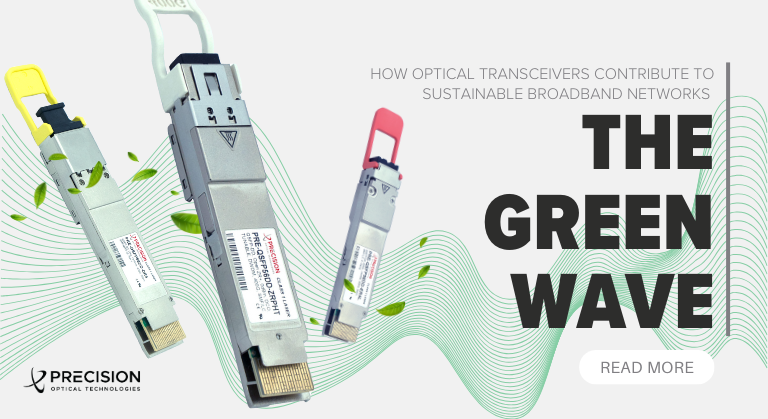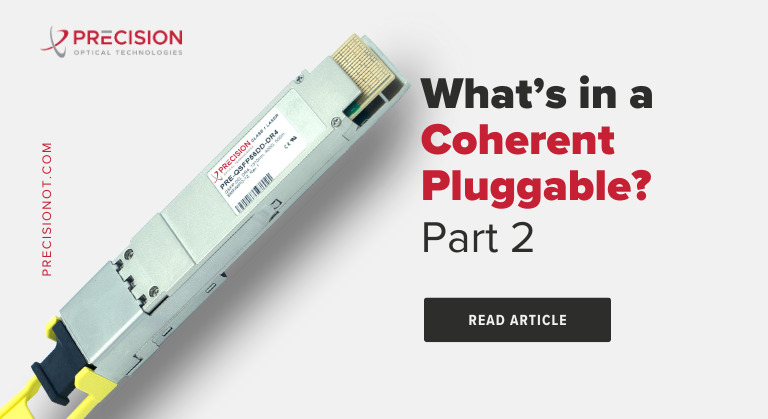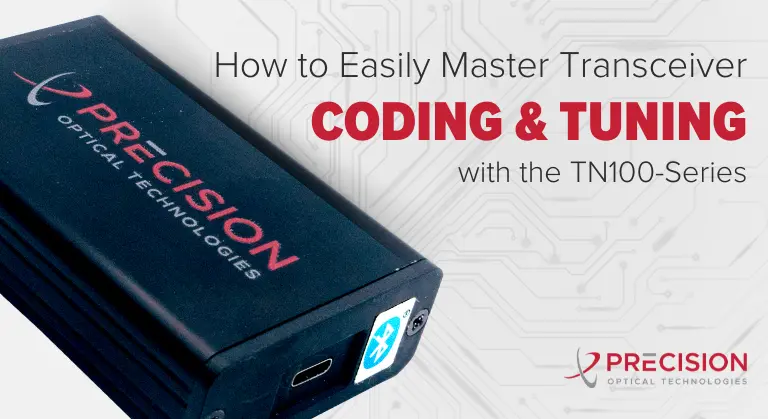
Future-Proofing Access Networks: Bridging the Gap Between Link Distance & Performance at the Edge

Precision OT’s latest development, the GeneseeTM Dispersion Compensation ASIC-enabled 25G tunable transceiver, can help accommodate growing bandwidth demands and ease upgrade path complexities. Here’s how.
In the rapidly evolving world of access network technologies, network operators are facing a significant challenge. Facing tight timelines and tight budgets, they are under increasing pressure to maximize the capabilities of their existing infrastructure even as they adopt technologies like Extended Spectrum DOCSIS (ESD), DOCSIS 4.0, R-OLT PON uplinks, and various 5G fronthaul/backhaul solutions. In other words, network operators need to bring higher data rates to the edge of their networks using what they already have.
Meeting this requirement has historically been no easy feat, especially when it has come to DWDM optical networks. The problem, of course, has been chromatic dispersion, which becomes more pronounced as transmission distances increase and transmission speeds exceed 10G. Fortunately, a solution for overcoming the gap between link distance and performance exists. It’s our proprietary GeneseeTM Dispersion Compensation ASIC-enabled (application-specified integrated circuit) technology, which has enabled a cutting-edge, 25G tunable module that enables users to reach distances of 40km and beyond without leveraging specialized equipment. Here’s what this means for you, as an access network operator.
25G and the Historic Link Distance – Performance Trade Off
When pushing past 10G in the access network, it’s important to pay attention to optical link budget and optical signal-to-noise ratio (OSNR) considerations as well as the ever-increasing effects of chromatic dispersion. As link distance increases, so does the need for amplification (EDFAs), digital signal processors (DSPs), forward error correction (FEC) and other additional equipment. At bandwidths of 10G, chromatic dispersion limits network links to approximately 80km. That is an acceptable distance for 10G considering that most access networks span up to 80km. Times have changed, however, as more access network operators look to adopt 25G data rates.
When it comes to 25G optics, chromatic dispersion effectively limits link distance to 10 to 15km unless specialized equipment is used. For network operators looking to push their existing infrastructure further without having to spend more money on specialized equipment or significant changes to their network architecture, conventional 25G DWDM transceiver options have posed a distinct problem. There simply hasn’t been an effective solution to circumvent the link distance-performance tradeoff.
As we’ve written in a previous blog, pressure is mounting from potential DOCSIS 4.0 adopters to achieve 25Gbps DOCSIS as they contend with advancements in the FTTH PON sector that are enabling it to push past symmetrical 10 Gbps to 25 and even 50 Gbps services. Already, the industry is discussing the idea of ESD DOCSIS at 1.8GHz, forming a launch pad for eventual 3 GHz, 25G ESD DOCSIS 4.0. In other words, across a number of access network technologies, the shift to 25G has already begun.
That said, when specialized equipment is required to overcome the distance limitations of 25G DWDM transceivers, the total cost of ownership and operation of an access network escalates. These additional costs not only strain the budgets of operators but also render the operation of such networks economically challenging over the long run. This is a difficulty that access network operators must address to ensure that the transition to 25G technology is both technically feasible and economically viable.
The Way Forward: Precision OT’s Dispersion Compensation ASIC-enabled Technology
As we just announced at the beginning of October 2023, we’ve launched our GeneseeTM ASIC technology. This new ASIC has enabled a cutting-edge, 25G tunable module that enables users to reach transmission distances of 40km and beyond without the need for specialized equipment. Highly configurable, modulation agnostic, interoperable and expandable to other data rates, our Dispersion Compensation ASIC is a cutting-edge technology available on the market today that can help network operators achieve data rates of 25G using their existing infrastructure – an optimal solution for the tight economic climates access network operators are facing globally.
Our new ASIC relies on an electronic dispersion compensation modulator driver using optical single side band (O-SSB) modulation with analog pre-compensation integrated into the modulator driver. To translate that description of how our technology works into how it benefits you, let’s put it another way. Although there are many processing tools available for compensation, our pre-distortion technique offers an overwhelming advantage. By going the pre-compensation route, our technology simply swaps a single conventional component in an IMDD pluggable transceiver with a modified version that performs dispersion compensation. That means our technology is non-invasive. It doesn’t require changes to your fiber plants.
In short, the GeneseeTM ASIC enables greater bandwidth over longer distances without the need for costly investments in additional equipment or new architecture. In fact, it extends the lifespan of your existing network infrastructure, enabling seamless integration with already-deployed passive components and making future upgrades simpler. As a testament to the groundbreaking nature of this technology, the GeneseeTM was recently given a 4.0 diamond rating by the 2023 Broadband Technology Report’s Diamond Technology Reviews. We also demonstrated it in a TSFP28-40(I) (tunable 25G extended reach model) at the SCTE Cable-Tec Expo in Denver, Colorado. You can view the full demo here.
To put it simply, if you’re looking to do more with what you have and circumvent the historical need for additional equipment, reach out with your questions today. We’d be happy to tell you more about our Dispersion Compensation ASIC and how it can work for you.






